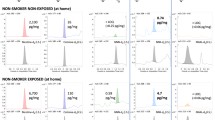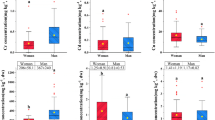Abstract
Tobacco is smoked by different techniques through cigarette and shisha smoking. The prevalence of tobacco is considered one of the major threats to public health. This study aims to assess the effect of cigarette, shisha, and mixed (cigarette/shisha) smoking on heavy metal contamination in hair samples, hair loss, and DNA fragmentation, to correlate age, incidence of hair loss, and smoking duration with the amount of accumulated metals and the DNA fragmentation, and to correlate the level of heavy metal contamination with DNA fragmentation. This study was implemented in Saudi Arabia among sixty males divided into four groups (15/group): control and cigarette, shisha, and mixed smokers. Heavy metal contamination in hair samples and urinary DNA levels were assayed. All metal and urinary DNA levels were significantly elevated in cigarette, shisha, and mixed smokers compared to non-smokers. Hair loss was also higher among smokers especially among participants with high DNA concentrations. There were positive significant correlations of age and incidence of hair loss with urinary DNA concentration. There were positive significant correlations between urinary DNA concentration and all heavy metal levels. Cigarette, shisha, and mixed smoking trigger metal contamination, DNA fragmentation, and hair loss. Moreover, hair loss was observed to be associated with Sb, Cd, and Ni as well as urinary DNA level, while age was associated only with lead and urinary DNA levels. The duration of smoking had a major impact on Pb and Sb levels. Finally, contamination with all six metals was significantly associated with DNA fragmentation.




Similar content being viewed by others
Data availability
All data and materials are included in the submitted article.
References
Ahmed AS, Elgharabawy RM, Ahmed HA, Barghash SS (2016) Human hair and nails as bio-indicator of heavy metals contamination by hair dye exposure among population in Saudi Arabia. World J Pharm Med Res 2:130–137
Al-Kazwini A, Sdepanian S, Said AJ (2014) Determination of macro and trace elements in moassel used in waterpipe in Jordan. Public Health Res 4:39–44
Almotairi HM (2012) Smoking in Saudi Arabia and its control measures. Brit J Human Soc Sci 5:69–75
AL-Ramadi MA, AL-Askar NA, Mostafa GAE (2017) Simultaneous determination of some heavy metals in nail samples of Saudi Arabian smokers by inductive coupled plasma mass spectrometry. Biomed Res 28:4568–4574
Alrobaian M, Arida H (2019) Assessment of heavy and toxic metals in the blood and hair of Saudi Arabia smokers using modern analytical techniques. Int J Anal Chem 2019:1–8
Belcheva A, Ivanova-Kicheva M, Tzvetkova P, Marinov M (2004) Effects of cigarette smoking on sperm plasma membrane integrity and DNA fragmentation. Int J Androl 27:296–300
Bernhard D, Rossmann A, Wick G (2005) Metals in cigarette smoke. IUBMB Life 57:805–809
Bozzola JJ, Russell LD (1999) Electron microscopy: principles and techniques for biologists, 2nd (Edn.) edn. Jones & Bartlett publishers, Sudbury
Bukhari IH, Rasul N, Kausar S, Naqvi SAR, Ali Z, Riaz M (2013) Comparative studies of Ni, Cd, Mn, Co, Pb, Cr and Zn in hair, nail and plasma of smokers and non-smokers subjects of Sargodha zone. IJCBS 4:28–37
Calleja A, Ríos V, Luque M, Ostos R, Grilo A, Camean AM, Moreno L (2014) Development of a new method for the determination of manganese, cadmium, mercury and lead in whole blood and amniotic fluid by inductively coupled plasma mass spectrometry. J Toxins 1:10
Chaouachi K (2009) Hookah (shisha, narghile) smoking and environmental tobacco smoke (ETS): a critical review of the relevant literature and the public health consequences. Int J Environ Res Public Health 6:798–843
Chiba M, Masironi R (1992) Toxic and trace elements in tobacco and tobacco smoke. Bull World Health Organ 70:269–275
Ercal N, Gurer-Orhan H, Aykin-Burns N (2001) Toxic metals and oxidative stress part I: mechanisms involved in metal induced oxidative damage. Curr Med Chem 1:529–539
Genchi G, Sinicropi MS, Carocci A, Lauria G, Catalano A (2017) Mercury exposure and heart diseases. Int J Environ Res Public Health 14:1–13
Hays AM, Srinivasan D, Witten ML, Carter DE, Lantz RC (2006) Arsenic and cigarette smoke synergistically increase DNA oxidation in the lung. Toxicol Pathol 34:396–404
International Agency for Research on Cancer (2004) Inorganic and organic lead compounds. IARC Monogr Eval Carcinog Risks Hum 87, Lyon: France
Iskander FY (1985) Determination of trace elements in cigarette filter before and after smoking. J Radioanal Nucl Chem 91:191–196
Jaishankar M, Tseten T, anbalagan N, Mathew B, Beeregowda K (2014) Toxicity, mechanism and health effects of some heavy metals. Interdiscip Toxicol 7:60–72
Järup L (2003) Hazards of heavy metal contamination. Br Med Bull 68:167–182
John P, Cunha D (2017) Hookah vs. cigarette smoking (addiction and health dangers) [internet]. Med Net 1–4. https://www.rxlist.com/hookahs_vs_cigarettes_addiction_and_health_dangers/article.htm
Knishkowy B, Amitai Y (2005) Water-pipe (narghile) smoking: an emerging health risk behaviour. Pediatrics 116:113–119
Labib N, Radwan G, Mikhail N, Mohamed MK, Setouhy ME, Loffredo C, Israel E (2007) Comparison of cigarette and water pipe smoking among female university students in Egypt. Nicotine Tob Res 9:591–596
Liang G, Pan L, Liu X (2017) Assessment of typical heavy metals in human hair of different age groups and foodstuffs in Beijing, China. Int J Environ Res Public Health 14:1–10
Martin S, Griswold W (2009) Human health effects of heavy metal. Environ Sci Technol Briefs Citiz 15:1–6
Masadeh MM, Hussein EI, Alzoubi KH, Khabour O, Shakhatreh MA, Gharaibeh M (2015) Identification, characterization and antibiotic resistance of bacterial isolates obtained from waterpipe device hoses. Int J Environ Res Public Health 12:5108–5115
Matta G, Gjyli L (2016) Mercury, lead and arsenic: impact on environment and human health. J Chem Pharm Sci 9:718–725
Moradi-Lakeh M, Bcheraoui EL, Tuffaha M, Daoud F, Alsaeedi M, Basulaiman M et al (2015) Tobacco consumption in the Kingdom of Saudi Arabia, 2013: findings from a national survey. BMC Public Health 15:1–10
Nanodrop 1000 Spectrophotometer v3.8 User’s Manual (2010) Thermo Fisher Scientific Inc
Navas-Acien A, Silbergeld EK, Sharrett R, Calderon-Aranda E, Selvin E, Guallar E (2005) Metals in urine and peripheral arterial disease. Environ Health Perspect 113:164–169
Przybylowicz A, Chesy P, Herman M, Parczewski A, Walas S, Piekoszewski W (2012) Examination of distribution of trace elements in hair, fingernails and toenails as alternative biological materials. Application of chemometric methods. Cent Eur J Chem 10:1590–1599
QIAamp® DNA Micro Handbook (2010) QIAGEN corporation
Rashed MN, Hossam F (2007) Heavy metals in fingernails and scalp hair of children, adults and workers from environmentally exposed areas at Aswan, Egypt. Environ Bioindic 2:131–145
Richter PA, Bishop EE, Wang J, Swahn MH (2009) Tobacco smoke exposure and levels of urinary metals in the U.S. youth and adult population: the National Health and Nutrition Examination Survey (NHANES) 1999–2004. Int J Environ Res Public Health 6:1930–1946
Safizadeh H, Moradi M, Rad MR, Nakhaee N (2014) Bacterial contamination of different components of the waterpipe. Int J Tuberc Lung Dis 18:988–991
Salma M, Rehman R, Anwar J, Mahmud T (2012) Statistical analysis of selected heavy metals by ICPOES in hair and nails of cancer and diabetic patients of Pakistan. Electr J Env Agr Food Chem 11:163–171
Satarug S, Moore MR (2004) Adverse health effects of chronic exposure to low-level cadmium in foodstuffs and cigarette smoke. Environ Med 112:1099–1103
Shakya PR (2007) Nickel adsorption by wild type and nickel resistant isolate of Chlorella sp. Pak J Anal Environ Chem 2007(8):86–90
Stillman RJ, Rosenberg MJ, Sachs BP (1986) Smoking and reproduction. Fertil Steril 46:545–566
Su L, Chen TH (2007) Association of androgenetic alopecia with smoking and its prevalence among Asian men: a community-based survey. Arch Dermatol 143:1401–1406
Sundar S, Chakravarty J (2010) Antimony toxicity. Int J Environ Res Public Health 7:4267–4277
Tchounwou PB, Yedjou CG, Patlolla AK, Sutton DJ (2012) Heavy metals toxicity and the environment. EXS 10:133–164
The Agency for Toxic Substances and Disease Registry (ATSDR) (2017) A priority list of hazardous substances U.S. https://www.atsdr.cdc.gov/spl/#2017spl. Accessed 10 Aug 2017
Trüeb RM (2003) Association between smoking and hair loss: another opportunity for health education against smoking. Dermatology 206:189–191
World Health Organization WHO (2019) Tobacco. Available at: https://www.who.int/news-room/fact-sheets/detail/tobacco. Accessed 5 Feb 2019
Author information
Authors and Affiliations
Contributions
Amira S. Ahmed and Rehab M. Elgharabawy conceived and designed the research, interpreted, analyzed, and discussed the obtained data. Hatem A. Ahmed conducted the determination of heavy metals in hair samples. Ahmed M. Refaat conducted the isolation and estimation of urinary DNA. Amira S. Ahmed, Albatool S. Alsalloumi, and Rawan A. Almasuood collected the hair and urine samples. Amira S. Ahmed, Rehab M. Elgharabawy, Maha A. Aldubayan, Albatool S. Alsalloumi, and Rawan A. Almasuood wrote the manuscript, and all authors commented on previous versions of the manuscript. Finally, all authors read and approved the manuscript.
Corresponding author
Ethics declarations
Conflict of interest
The authors declare that they have no conflict of interest.
Ethical approval
The protocol of this study was approved by the ethical committee of the college of pharmacy, Qassim University, KSA.
Consent to participate
Informed consent was collected from all participants in this study.
Consent to publish
Not applicable.
Additional information
Responsible Editor: Philippe Garrigues
Publisher’s note
Springer Nature remains neutral with regard to jurisdictional claims in published maps and institutional affiliations.
Rights and permissions
About this article
Cite this article
Ahmed, A.S., Aldubayan, M.A., Ahmed, H.A. et al. Impact of smoking on heavy metal contamination and DNA fragmentation. Environ Sci Pollut Res 28, 13931–13941 (2021). https://doi.org/10.1007/s11356-020-11633-y
Received:
Accepted:
Published:
Issue Date:
DOI: https://doi.org/10.1007/s11356-020-11633-y




